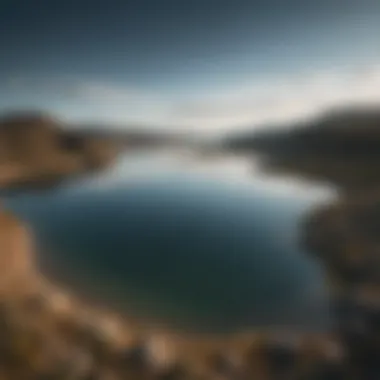Pond vs Lake: Understanding Aquatic Ecosystems


Intro
Understanding the distinctions between ponds and lakes is vital for anyone interested in freshwater ecosystems. These two bodies of water, while seemingly similar, contain a myriad of differences that impact both the environment and the organisms that inhabit them. This article aims to meticulously dissect the traits, ecological significance, and the influence of human interactions on these aquatic ecosystems.
Overview of Research Topic
Brief Background and Context
Ponds and lakes serve as critical components of the hydrological cycle and support a diverse range of flora and fauna. They are vital for maintaining ecological balance and providing habitats for numerous species. The differences between these water bodies often arise from variations in size, depth, and nutrient levels.
For instance, ponds are typically smaller and shallower than lakes, facilitating sunlight penetration and fostering diverse plant life. Lakes, on the other hand, tend to have greater depths, which can lead to stratification—layers of water that differ in temperature and oxygen content. Understanding these physical and chemical differences is essential in appreciating the roles ponds and lakes play in supporting life and their responses to environmental changes.
Importance in Current Scientific Landscape
In recent years, the focus on freshwater ecosystems has intensified due to increasing environmental concerns, such as pollution and climate change. By investigating the distinctions between ponds and lakes, researchers can develop better conservation strategies. Moreover, this knowledge assists in ecological restoration efforts, aiming to rejuvenate degraded environments. The importance of this topic extends beyond academic relevance; it touches on pressing issues connected to sustainability, biodiversity, and human impact on the environment.
Methodology
Research Design and Approach
This article employs a multidisciplinary approach, intersecting biology, hydrology, and environmental science. By synthesizing various studies and reports, it seeks to present a comprehensive overview of both ponds and lakes, highlighting their unique aspects and common characteristics.
Data Collection Techniques
Data will be accumulated from various credible sources, including academic journals, environmental organizations, and online resources such as Wikipedia and Britannica. Observational studies, experiments, and modeling data will support the findings, ensuring a rigorous examination of the differences and similarities between ponds and lakes.
Defining Aquatic Ecosystems
Understanding aquatic ecosystems is critical to grasping the interplay between various freshwater bodies, particularly ponds and lakes. This section invites readers to explore how these ecosystems function, their structure, and the fundamental roles that ponds and lakes play within the global hydrological cycle. By defining these ecosystems, this article illuminates the unique attributes that distinguish ponds from lakes and highlights their ecological contributions to biodiversity and environmental sustainability.
Foreword to Freshwater Bodies
Freshwater bodies encompass numerous water environments, including rivers, streams, ponds, and lakes. Ponds and lakes are two significant types that often get grouped together but possess distinct differences. Ponds are smaller and shallower; lakes are generally larger and deeper, influencing their ecosystems. These freshwater bodies are vital to ecological health and serve various functions, such as habitat for wildlife, sources of drinking water, and recreational opportunities for humans.
In many ways, the life of the ecosystem is dictated by its size and depth. The morphology of these water bodies affects light penetration, temperature gradient and nutrient distribution. Both ponds and lakes are essential for a rich biodiversity, hosting various plant and animal species that depend on these environments for survival.
Context and Importance
The significance of ponds and lakes extends beyond their biological role. They contribute to climate regulation, water purification, and flood control. Understanding these aquatic ecosystems offers insights into their responses to environmental stressors, especially as human activities increasingly threaten their integrity. Awareness of the dynamics at play in these ecosystems is crucial for sustainable management.
Key considerations regarding the relevance of defining aquatic ecosystems include:
- Ecological Balance: Both ponds and lakes contribute to the maintenance of ecological balance within their respective regions.
- Biodiversity Hotspots: They often serve as habitats for numerous species, including fish, amphibians, birds, and aquatic plants.
- Human Use and Interaction: Freshwater bodies are integral to human life, providing resources for agriculture, industry, and recreation.
- Climate Change Indicators: The health of these ecosystems can indicate broader environmental changes due to climate conditions.
"Ponds and lakes are not just bodies of water, they are vibrant ecosystems that support life extensively."
Understanding aquatic ecosystems is essential for students, researchers, educators, and professionals involved in environmental science. It provides a foundation for addressing larger environmental challenges and developing sound conservation practices.
Characteristics of Ponds
The exploration of ponds within the aquatic ecosystem is crucial due to their unique characteristics and functions. Ponds represent a specific type of freshwater ecosystem that displays distinct features compared to lakes. Understanding these characteristics aids in grasping the broader implications these bodies of water have on biodiversity and environmental health.
Defining Features of Ponds


Ponds are generally smaller than lakes, often characterized by shallow waters that allow sunlight to penetrate to the bottom. This aspect is critical as it supports plant growth, fostering a lush habitat for microorganisms and small aquatic organisms. The edges of ponds typically feature a rich biodiversity of flora and fauna.
In terms of their physical structure, ponds often lack the depth of lakes, and their boundaries are usually well-defined. This clear delineation is important for the ecosystems that thrive within them. Ponds often experience more frequent water exchange due to smaller volumes, which can result in varying temperature and chemical properties.
Size and Depth
The scale of ponds is another informing characteristic. While there is no strict definition of size, most ponds are considered to be under 20 acres in surface area. This small scale influences their depth, which usually does not exceed 10-12 feet. The shallow nature often leads to warm temperatures, particularly in the summer months.
Shallowness also promotes ecological interactions; fish species like minnows and amphibians rely on these habitats for breeding. Additionally, the low volume allows for swift nutrient cycling, which is vital for the sustenance of the aquatic life therein.
Biodiversity in Ponds
Ponds serve as essential reservoirs of biodiversity. Their unique conditions support a variety of life, including invertebrates, fish, amphibians, and various plant species. The warm waters and abundant sunlight in ponds create ideal environments for growth and reproduction.
It is common to find different plant species along the edges of ponds, such as cattails and water lilies. These plants not only provide habitats but also play a role in water purification through filtration. Ponds can support both permanent residents and migratory species, making them vital for ecological continuity.
"Ponds are often underappreciated yet serve as critical lifelines for numerous species."
Through an understanding of the defining features, size, depth, and biodiversity present in ponds, one can observe their vital contribution to the ecosystem. Their significance cannot be overstated; they play a pivotal role in supporting life, enhancing biodiversity, and contributing to the management of water resources.
Characteristics of Lakes
The characteristics of lakes are fundamental to understanding their ecological roles and functions. Lakes are not just large bodies of freshwater; they present a diverse range of features that impact surrounding environments and organisms. Analyzing these characteristics gives insight into how lakes differ from ponds, how they evolve, and how they sustain various life forms.
Defining Features of Lakes
Lakes vary significantly from ponds in their physical and chemical properties. Typically, lakes are larger and deeper. They exhibit a distinct stratification, which influences temperature variations within layers of water. This stratification can be categorized into three main zones: the epilimnion (the top layer, warmer and mixed by wind), the metalimnion (the middle layer, where temperature drops sharply), and the hypolimnion (the bottom layer, colder and denser).
Also, the nature of the shoreline plays an important role. Lakes often have a defined perimeter, with cliffs or trees, leading to a greater potential for habitat diversity compared to ponds. The depth of lakes may allow for greater aquatic life, including fish species that prefer deeper waters for breeding and feeding.
Scale and Volume
When considering scale and volume, lakes are often measured in acres or hectares, while ponds are generally much smaller, typically less than 20 acres. The sheer volume of water in a lake influences its ecosystem's ability to support larger populations of fish, amphibians, and aquatic plants. Larger lakes can also sustain more complex food webs due to the variety of habitats available.
Another aspect of scale is the catchment area or watershed that feeds the lake. This area directly contributes to its health by bringing nutrients and water. The larger the watershed, the more complex its hydrology can become. Flooding events, sediment transport, and nutrient runoff from surrounding landscapes all affect the water quality and ecological dynamics within that lake.
Ecosystem Variety in Lakes
Lakes exhibit high ecosystem diversity. This diversity is due in part to the variety of habitats created by the lake's physical features. From shallow banks supporting wetland habitats to the bottom depths of the hypolimnion, these habitats support varying biological communities.
Lakes often harbor diverse fish populations such as bass, trout, or perch, depending on water temperature, depth, and available nutrients. In addition, macroinvertebrates and aquatic plants are crucial in nutrient cycling and provide food sources for larger predators.
Moreover, lakes can host distinct ecosystems like those found in oligotrophic lakes, which are nutrient-poor, leading to clear waters and a specific set of adapted species, as well as eutrophic lakes, characterized by nutrient-rich environments resulting in algal blooms.
As a whole, the characteristics of lakes present a compelling study. They influence everything from biodiversity to human recreation activities. Recognizing the value of lakes contributes to better conservation strategies and enhances the understanding of aquatic ecosystems.
"Understanding the defining characteristics of lakes is essential for promoting their conservation and sustainable management."
This knowledge not only helps in conserving these habitats but also in establishing the connectedness of ecological systems we depend on.
Hydrological Processes
In understanding freshwater ecosystems, hydrological processes are central components that merit detailed examination. These processes govern the movement, distribution, and quality of water within both ponds and lakes. Factors such as water source dynamics, the occurrence of eutrophication, and thermal stratification have profound implications for the health and sustainability of these ecosystems. Each of these elements influences not only the aquatic life but also the surrounding environment.


Water Source Dynamics
Water source dynamics refer to the various ways in which water enters and leaves a pond or lake. For both types of freshwater bodies, the primary sources include precipitation, surface runoff, groundwater inflow, and, in some cases, human intervention through artificial means such as reservoirs.
- Precipitation can directly replenish the water body, influencing its size and chemical makeup.
- Surface runoff contributes nutrients and sediments, often altering the ecosystem's balance.
- Groundwater supplies can be crucial, especially in areas where surface water is scarce.
- Human activities, such as irrigation or urban runoff, can significantly change these dynamics, leading to increased nutrient loads and potential contamination.
The interplay of these factors affects not only the hydrology but also the biological communities in these ecosystems.
Eutrophication in Ponds and Lakes
Eutrophication is a primary concern in the management of freshwater bodies. The process involves nutrient enrichment, particularly from nitrogen and phosphorus, leading to excessive growth of algae and aquatic plants. While eutrophication can naturally occur, human activities often exacerbate it.
In ponds, eutrophication can result from:
- Fertilizer runoff from agricultural land.
- Waste discharge from livestock and humans.
- Sediment erosion that introduces nutrients into the water.
In lakes, the larger volume can sometimes mitigate severe impacts, but not always. Algal blooms can deplete oxygen levels as they decompose, creating dead zones where aquatic life cannot survive. Therefore, understanding eutrophication dynamics is critical for maintaining the health of these ecosystems.
Thermal Stratification in Lakes
Thermal stratification is a fundamental hydrological process particularly evident in lakes, where temperature differences create distinct layers within the water column. This stratification typically occurs during warmer months, dividing the lake into three layers: the epilimnion, metalimnion, and hypolimnion.
- Epilimnion is the warm upper layer that is well-mixed by wind and sunlight.
- Metalimnion serves as the transition zone, where temperature drops sharply over a short distance.
- Hypolimnion is the cold, deeper layer that remains stagnant until fall overturn occurs.
This stratification affects oxygen levels and nutrient distribution. In summer, the hypolimnion can become anoxic, affecting fish species and overall lake health. Understanding these temperature dynamics aids in predicting biological behavior and water quality changes throughout the seasons.
Efficient management of water source dynamics, eutrophication, and thermal stratification is vital for the sustainability of freshwater ecosystems.
By comprehending these hydrological processes, students, researchers, and environmental professionals can derive insights into the functioning and health of pond and lake ecosystems.
Ecological Importance
Understanding the ecological importance of ponds and lakes is crucial in recognizing their roles within local environments. These freshwater bodies serve as vital components of ecosystems, influencing both biological diversity and the physical landscape.
Role in Local Ecosystems
Ponds and lakes function as ecosystems that support a variety of life. They provide essential habitats for fish, amphibians, reptiles, and numerous invertebrates. The presence of aquatic plants contributes to nutrient cycling, and these species often serve as primary producers. Moreover, moist environments around these bodies attract terrestrial fauna such as birds and mammals, further enhancing biodiversity.
The interaction between aquatic and terrestrial ecosystems creates a complex web of life. Birds, for example, may feed on fish or insects found in ponds and lakes, which can create a balance among species populations.
Contributions to Biodiversity
Ponds and lakes contribute significantly to overall biodiversity. They host many unique organisms that are specifically adapted to freshwater environments. For example, certain species of frogs can only thrive in shallow pond habitats.
In addition to supporting distinct aquatic life, ponds and lakes act as migratory stopovers for birds. Many migratory species rely on these freshwater sources during their travels, showcasing the interdependence of biodiversity in these ecosystems. An increase in biodiversity above and below water can lead to more resilience and stability in these environments.
Services Provided by Ponds and Lakes
Ponds and lakes offer a range of ecosystem services that are beneficial to both nature and humanity. Some of the key services include:
- Water Purification: Ponds can improve water quality by filtering pollutants and sediments before they reach larger water bodies.
- Flood Control: Lakes provide storage for excess rainfall which helps to mitigate flood risks.
- Recreation: Many people enjoy fishing, kayaking, or simply relaxing by these bodies of water. These activities support mental well-being and community interactions.
- Carbon Sequestration: Aquatic plants in ponds and lakes help sequester carbon. Thus contributing positively to climate change mitigation.
"Ecosystem services play a significant role in enhancing quality of life and supporting economic activities."


In summary, the ecological importance of ponds and lakes cannot be overstated. They are not only critical for wildlife but also provide invaluable services that maintain environmental health and support human life.
Human Impact on Ponds and Lakes
Human activity affect both ponds and lakes significantly. The interactions can lead to both beneficial and harmful consequences. Understanding these impacts is essential for effective management and conservation of these critical freshwater ecosystems.
Pollution in Freshwater Bodies
Pollution is one of the most pressing issues facing ponds and lakes today. Water bodies can face contamination from various sources. Agricultural runoff, for instance, introduces pesticides and fertilizers, leading to adverse effects on aquatic life. Urban areas contribute to this problem through stormwater runoff, containing pollutants like oil, heavy metals, and household waste.
Consequences include eutrophication, which causes excessive growth of algae. This phenomenon can deplete oxygen levels in the water, harming fish and other aquatic organisms. When fish populations decline, the entire ecosystem suffers. According to recent studies, this process not only affects biodiversity but can also alter food webs, leading to long-term ecological imbalances.
Urban Development Challenges
As populations grow, urban development increasingly encroaches on natural bodies of water. Ponds and lakes often become sites for residential and commercial projects. This development can disrupt local habitats and change the hydrology of these ecosystems.
Often, natural filtration systems are destroyed, increasing sedimentation and pollution levels. Also, impervious surfaces increase runoff, exacerbating pollution issues. These changes may lead to the degradation of water quality. Consequently, fish and wildlife can struggle to adapt or survive in their altered environments.
Addressing these challenges requires awareness and planning. Zoning laws and sustainable development practices can help mitigate some of the negative effects of urbanization on freshwater systems.
Conservation Efforts
Efforts to conserve ponds and lakes are varied and important. Organizations and governments are implementing strategies to protect these vital ecosystems. These efforts often involve pollution prevention, habitat restoration, and public education.
For example, establishing protected areas can help safeguard habitats from the impacts of urbanization and agriculture. Programs that encourage sustainable practices in farming and landscaping can also significantly reduce runoff pollution. Furthermore, community engagement initiatives play a crucial role in educating the public on the importance of local water bodies.
Finale
The conclusion of this article serves a critical role in synthesizing and reinforcing the findings presented throughout the discussion regarding the differences between ponds and lakes. It is not merely a recap, but a deep reflection on the significance of these freshwater bodies in their respective ecosystems. Understanding the distinctions that separate ponds from lakes brings forth an appreciation of their unique roles in biodiversity, ecosystem functioning, and human interactions.
Summary of Key Differences
In summarizing the key differences, we must emphasize several critical factors that define ponds and lakes:
- Size and Depth: Ponds generally are smaller and shallower compared to lakes. This size difference impacts the light penetration and subsequent biological activities within these ecosystems.
- Biodiversity: Lakes tend to harbor a wider array of species due to their scale and complexity of habitats. In contrast, ponds may have a more limited biodiversity, yet they play an equally important role in supporting various organisms.
- Hydrological Processes: The dynamics of water movement differ significantly between the two environments. Lakes often experience stratification, whereas ponds may not have such complex thermal layers.
- Human Impact: Both systems are affected by pollution and urban development differently. Ponds are often more vulnerable to these impacts due to their size and relative isolation.
The relationships among these differences illustrate how while both ponds and lakes are integral to aquatic ecosystems, their functioning and ecological roles can vary extensively.
Future Directions for Research
Looking ahead, more research is essential to fully understand the intricate dynamics of ponds and lakes. Areas for future exploration could include:
- Impact of Climate Change: As the climate is changing, the effects on the physical and biological characteristics of ponds and lakes must be documented and understood.
- Restoration Ecology: Investigating methods for restoring degraded ponds and lakes can contribute to the enhancement of their ecological integrity and biodiversity.
- Invasive Species Management: Understanding how invasive species alter the ecosystem roles of ponds and lakes is vital for effective management strategies.
- Human Interaction Studies: Assessing how local communities interact with and influence these bodies of water can provide insights into sustainable practices.
This focused research will not only enrich our understanding of aquatic ecosystems but also foster better management and conservation practices. Thus, the discussions around ponds and lakes are far from concluded; rather, they are a gateway to further inquiry and exploration.
Key Studies on Ponds and Lakes
The body of research focused on ponds and lakes is extensive. Numerous studies have delved into various aspects such as biodiversity, hydrology, and ecological impacts. Significant works include empirical research conducted on the nutrient dynamics in small ponds versus larger lakes. Studies such as these highlight distinct ecological processes, as noted in works published by the Journal of Aquatic Ecosystem Stress and Recovery.
This body of literature consistently emphasizes the differences in species distribution within these ecosystems. For instance, some research indicates that ponds often support a unique assemblage of microhabitats, fostering diversity that may not be present in larger lakes.
Among the notable references, the findings from the Freshwater Biology Journal detail extensive field studies highlighting how human activity affects the health of these water bodies. Over time, these studies have accumulated significant data contributing to our understanding of freshwater ecosystems and their conservation needs.
Further Reading
To gain a deeper appreciation for the complexities of ponds and lakes, several resources stand out.
- Encyclopedia of Freshwater Biology - This comprehensive text covers a broad range of topics, providing a solid overview of the aquatic environments.
- The Effects of Anthropogenic Influences on Aquatic Ecosystems published by Britannica offers insights into the human impact on lakes and ponds, emphasizing urgent conservation efforts.
- Research publications on the relationships between terrestrial and aquatic ecosystems can also provide profound insights into how these systems interact. Reading information from relevant sources like reddit.com or academic articles from reliable journals can enhance understanding.
- For discussions on recent advancements and findings in the field, users are encouraged to explore forums and publications found on facebook.com.
These resources equip students, researchers, and educators with a deeper understanding of the dynamics that define aquatic ecosystems, expanding the conversation beyond the article’s scope.



